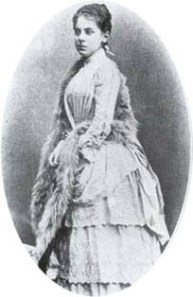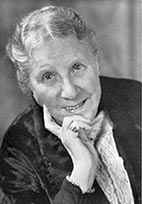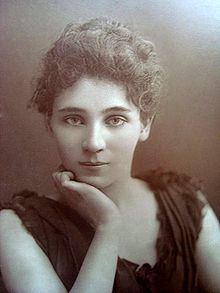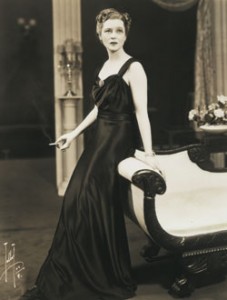After a decade of praise for creating a modern style of drama, Ibsen found himself in a situation that would ultimately lead to the creation of arguably his greatest work, Hedda Gabler.
Ibsen had become, at 61 years old, the source of infatuation for an assortment of young girls. The success was undoubtedly going to the playwright’s head, and the previously inhibited (and married) man confidently pursued the relationships much further than he would have before his fame.

Emilie Bardach
While Ibsen was summering in northern Italy in 1889, Emilie Bardach, an eighteen-year-old from Vienna, fell in love with the 61-year-old playwright. Ibsen appeared to reciprocate her feelings, talking of leaving his wife and son for the young woman. “But for various reasons,” explains Ibsen’s biographer Michael Mayer, “fear of scandal, sense of duty towards his wife, consciousness of old age, perhaps the consciousness or fear of impotence—he, who had suppressed his feelings for so long, and now had the opportunity to fulfill them, shrank from the test.” Instead, Ibsen returned to Munich and struck up another infatuation, which also went nowhere. The object of this new set of affections, Helene Raff, wrote later, “Ibsen’s relations with young girls had in them nothing whatever of infidelity in the usual sense of the term, but arose solely from the needs of his imagination.”

Helene Raff
Meanwhile, the playwright poured himself into a new play, noting, “The great tragedy of life is that so many people have nothing to do but yearn for happiness without ever being able to find it.” He also wrote in a letter to Helene, “To me will is always the most important thing. Few people have strong wills. It always strikes me as comical when people tell me that something they wanted didn’t work out. They have merely desired or longed for something, not willed it. He who really wills something attains his goal.” Still consumed by his inability to act with regards to these young women, in his new play, Hedda Gabler, Ibsen would delve into the theme of “self-emancipation unattained because of the seeker’s own deficiency,” as put by scholar Hans Georg Meyer. This highly personal play, referred to as a “Portrait of the Dramatist as a Young Woman” by his biographer, would become arguably the most respected creation of the playwright’s storied legacy.
Once again, the critics savaged the London premiere of Ibsen’s new work, earning the worst reviews of his career to that point. The Saturday Review condemned what it called “mean and sordid philosophy [and] insidious nastiness…photographic studies of vice and morbidity,” and Pictorial World called it a “hideous nightmare of pessimism. The play is simply a bad escape of moral sewage-gas. Hedda’s soul is a-crawl with the foulest passions of humanity.” The play did have its admirers though, including Thomas Hardy, Henry James, Bernard Shaw, and Oscar Wilde, who wrote “I felt pity and terror, as though the play had been Greek.”
Why were Ibsen’s plays—Hedda Gabler in particular—so unappreciated upon their debut? Ibsen’s biographer Michael Meyer explains a key obstacle for Victorian audiences: “People who could comprehend a complex character in a novel, with the aid of narrative explanation and the character’s reflections, were often helpless when faced with the same character expressed only through dialogue.” Modern audiences expect this when attending the theatre, but Ibsen was the first playwright to compose drama in such a way. Additionally, the play is written entirely in short exchanges of just a few sentences, also unusual for plays at that time.
Despite its cold initial reception, the play, and Ibsen himself, continued to gain acceptance and popularity in a very short time. In the half century following the play’s debut in America in 1898, there were 15 Broadway productions. It remains the most produced of Ibsen’s plays in both the United Kingdom and the United States. By the time Ibsen died in 1902 at the age of 78, his influence was assured and thousands came to pay their respects. Fittingly, the playwright’s last word was “tvertimod!”, which means “on the contrary.”

Elizabeth Robins, 1893
The role of Hedda remains one of the most desired roles for an actress. Elizabeth Robins originated the role in London and starred in the first Broadway production. Other notable actresses to play the role over the years include Eva Le Gallienne (1928, renowned as one of the best interpretations), Peggy Ashcroft (1954), Maggie Smith (1970, in a production directed by Swedish auteur Ingmar Bergman), Claire Bloom (1971), Glenda Jackson (1975), Diana Rigg (1981, TV movie), Fiona Shaw (1991), Annette Bening (1999), Martha Plimpton (2001, Steppenwolf), Kate Burton (2002), Cate Blanchett (2006), and Mary-Louise Parker (2009). The Nicholas Rudall translation of the play first premiered at Court Theatre in Chicago in 1984, with Writers Theatre favorite William Brown playing the role of Eilert Lovborg.

Eva Le Gallienne as Hedda at the Civic Repertory Theatre, 1928
All of Ibsen’s plays, and particularly his masterpiece Hedda Gabler, deeply influenced those following in his footsteps. Two of his younger contemporaries, Strindberg and Chekhov, while disliking Ibsen, continued to explore in their works the modern tragedy that Ibsen had created. Successive writers had no qualms putting Ibsen on a pedestal and acknowledging his influence on their writings. Pirandello declared, “After Shakespeare, I unhesitatingly place Ibsen first.” Eugene O’Neill called his work “intensely human and understandable” and “much nearer to me than Shakespeare.” But perhaps Swedish critic Martin Lamm put it best when he said, “Ibsen is the Rome of modern drama. All roads ultimately lead from him and to him.”
More on Hedda Gabler:
Articles | Videos | Production Details | Tickets


2 Comments
[…] “I’ve been very lucky to work closely with the dancers in some of the productions. When we performed the Dvorak Piano Quintet in Val Caniparoli’s Ibsen’s House, it was such a treat to play this gorgeous chamber music and to see Lorena Feijoo turn into a fiery Hedda Gabler. […]
very imformative narrative thank you